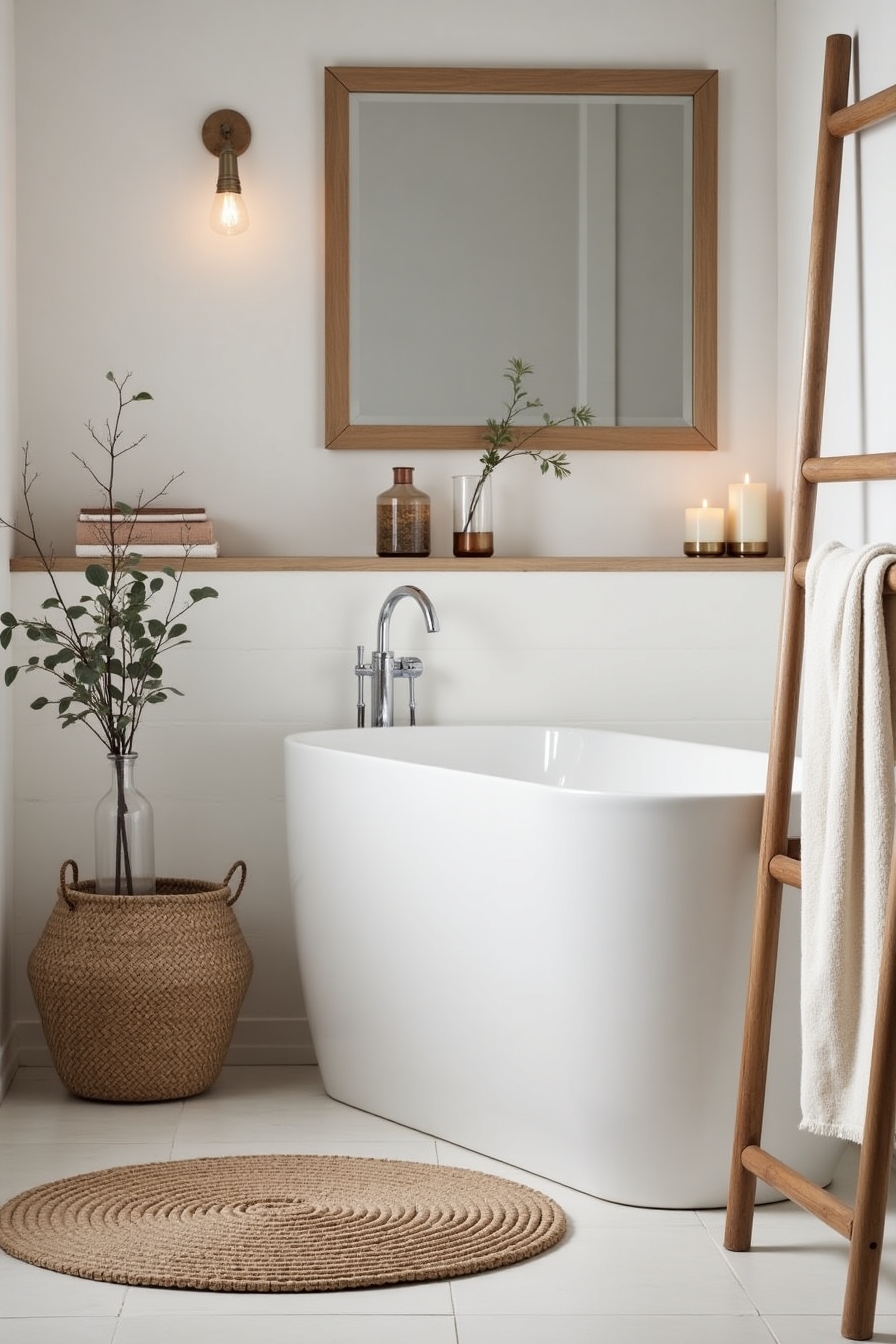There’s something undeniably magical about stepping into a true Scandinavian-style bathroom.
The perfect balance of minimalism and warmth instantly transforms an ordinary functional space into a tranquil sanctuary.
Scandinavian design has captivated the world for decades with its clean lines, practical functionality, and ability to create spaces that feel both contemporary and timeless.
In the bathroom, this design philosophy shines particularly bright, turning everyday routines into moments of calm and comfort.
The Nordic approach to bathroom design isn’t just about aesthetics—it’s a thoughtful response to long, dark winters and an appreciation for natural light and materials.
These spaces embrace simplicity without feeling stark, combining practicality with subtle luxury in a way that feels both attainable and aspirational.
✨Click to Get My 101 FREE Designer Room Ideas
Embrace a Clean White Canvas with Natural Wood Accents


The foundation of any Scandinavian bathroom begins with a predominantly white palette.
This isn’t just any sterile white, but a warm, soft white that reflects light beautifully.
The secret to preventing this white backdrop from feeling cold or clinical is the strategic incorporation of natural wood elements.
Think oak vanities with visible grain patterns that tell a story of their own.
Wood brings an immediate sense of warmth and organic texture that balances the crispness of white surfaces.
Consider a floating wooden vanity that contrasts against white walls and flooring.
The juxtaposition creates visual interest without overwhelming the senses.
For a more subtle approach, incorporate wooden accessories like bath trays, stools, or even picture frames.
These small touches can have a significant impact on the overall feel of your space.
Scandinavian design embraces natural materials that age beautifully over time.
Cedar or teak shower floors can add a spa-like element while providing practical benefits like natural water resistance.
The key is to keep wood finishes natural rather than heavily stained or painted.
Light to medium wood tones work best with the Scandinavian aesthetic, allowing the natural beauty of the material to shine through.
If you’re working with a smaller bathroom, a wood-framed mirror or wooden wall hooks can introduce the material without taking up valuable space.
Remember that in Scandinavian design, each element serves both a functional and aesthetic purpose.
Your wooden elements should contribute to the usability of the space while adding visual warmth.
Many homeowners find that this white-and-wood combination creates a timeless foundation that can evolve with changing tastes and trends.
Install Smart, Streamlined Storage Solutions

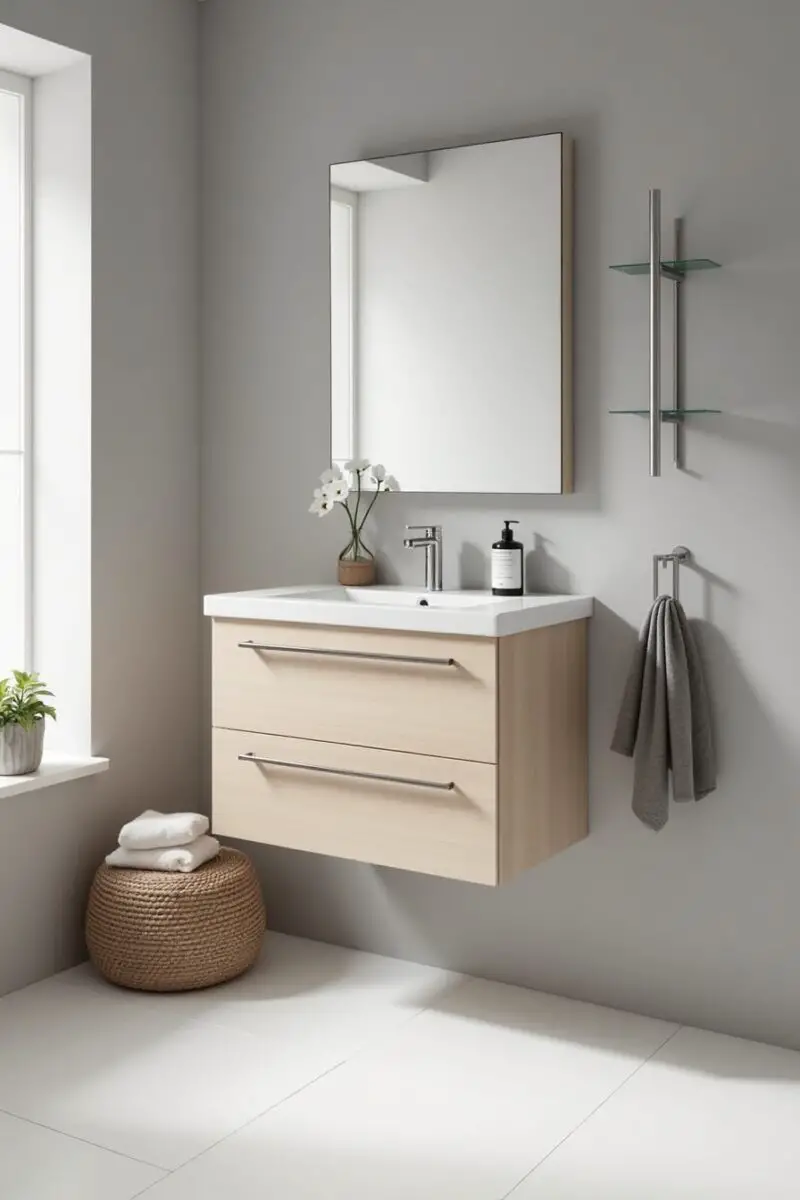
Clutter is the enemy of Scandinavian design, making thoughtful storage solutions essential to achieving this aesthetic.
True Scandinavian bathrooms embrace the concept of “a place for everything, and everything in its place.”
Wall-mounted cabinets with simple, handle-free designs help maintain clean lines while providing ample storage.
Built-in niches in shower walls eliminate the need for caddies and bottles along tub edges, creating a cleaner visual line.
Consider a medicine cabinet recessed into the wall, featuring a mirror on the outside and shelving inside for toiletries and medications.
These dual-purpose elements maximize functionality without sacrificing style.
Floating vanities not only create the illusion of more space but often include clever drawer systems with dividers specifically designed for bathroom essentials.
Look for vanities with soft-close features and water-resistant finishes that will stand up to bathroom humidity.
Open shelving, when used sparingly, can display a few carefully chosen items while encouraging you to keep those items tidy and minimal.
Think about incorporating baskets made from natural materials to corral smaller items while adding texture and warmth.
Custom built-ins that utilize otherwise wasted space, such as the area above the toilet or in awkward corners, maximize every square inch.
The beauty of Scandinavian storage lies in its thoughtfulness—items you use daily are easily accessible, while those used less frequently are neatly tucked away.
Wall hooks installed at strategic heights accommodate everything from bath towels to robes without taking up valuable floor or counter space.
Consider pull-out drawers rather than traditional cabinets under sinks, which make it easier to access items stored in the back.
Hidden storage behind mirrors or inside vanity toe kicks can provide surprisingle space for extra toilet paper, cleaning supplies, or seasonal items.
Remember that the goal isn’t just to hide everything away, but to create a system that makes your daily routine more efficient and pleasant.
Create a Spa-Like Shower Experience


Scandinavian bathrooms often feature walk-in showers that create a seamless flow throughout the space.
These walk-in designs typically eliminate barriers like curbs or shower doors that interrupt the visual continuity of the room.
Rainfall showerheads mounted directly to the ceiling provide a luxurious, immersive experience that mimics standing beneath a gentle waterfall.
Pair your rainfall shower with a handheld showerhead for practicality and flexibility in your daily routine.
Curbless shower entries not only create a modern, streamlined look but also improve accessibility for all ages and abilities.
Proper drainage is essential in these designs, typically achieved through a slight slope in the floor and a linear drain along one wall.
Frameless glass enclosures, when needed, maintain an open feel while containing water splash, allowing light to flow uninterrupted throughout the bathroom.
Consider a simple glass panel rather than a full enclosure if your space and layout allow for this more minimal approach.
Natural stone or wood-look tile flooring in the shower creates a sense of being connected to nature, even in this most interior space.
Recessed niches for shampoo and soap keep products organized and within reach while maintaining the clean aesthetic.
Built-in benches provide both convenience and a touch of luxury, offering a place to rest while enjoying the steam and warmth.
Minimalist fixtures in matte black, brushed brass, or chrome provide focal points against the predominantly white backdrop.
Thermostatic valves ensure constant water temperature, adding both safety and comfort to your shower experience.
For an authentic Scandinavian touch, consider incorporating a steam feature, nodding to the traditional Nordic sauna culture.
Proper ventilation systems, often hidden within the ceiling design, prevent humidity issues while maintaining the clean lines of your bathroom.
Remember that the Scandinavian shower philosophy centers on creating a calming ritual rather than just a functional necessity in your daily routine.
Incorporate Natural Stone with Subtle Veining
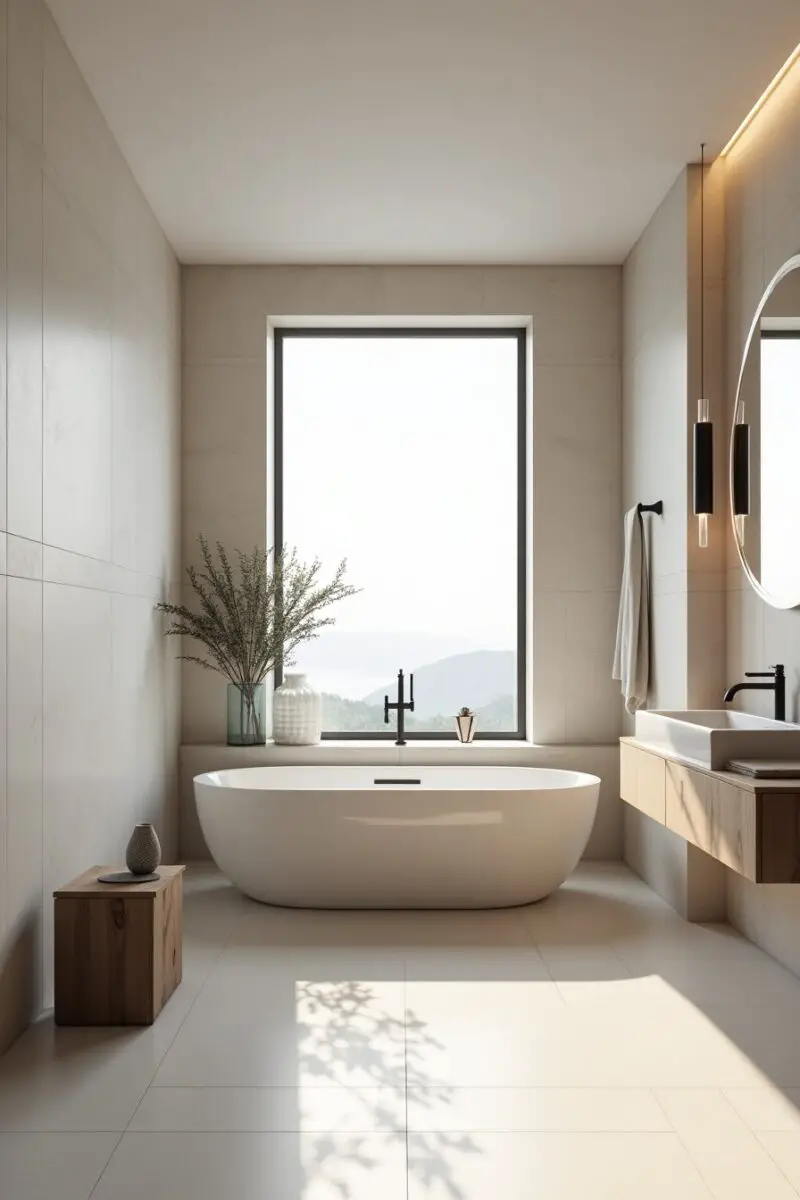

Natural stone is a cornerstone of Scandinavian bathroom design, bringing organic texture and timeless appeal to these serene spaces.
Unlike the bold, heavily veined marbles popular in some design styles, Scandinavian bathrooms favor stones with subtle, delicate veining patterns.
Look for light-colored marbles, limestones, or quartzites with soft gray or taupe veining that adds interest without overwhelming the space.
These materials can be used on floors, countertops, shower walls, or as accent pieces to introduce natural variation and character.
Honed or matte finishes are preferred over polished surfaces, creating a more organic, lived-in feel that aligns with the Scandinavian appreciation for natural beauty.
These non-reflective surfaces also tend to show fewer water spots and fingerprints, making them practical choices for bathroom environments.
Consider a monolithic stone sink carved from a single block of marble or limestone for a statement piece that feels both modern and timeless.
For a more budget-friendly approach, porcelain tiles that convincingly mimic natural stone can provide the look without the maintenance concerns.
Extend your stone selection to walls for a luxurious, wrapped effect that creates visual cohesion throughout the space.
Stone shower benches or window sills introduce the material in smaller doses while providing practical surfaces.
Mixing stones with similar tones but different textures can create subtle depth without compromising the cohesive, calm aesthetic.
Remember that natural stone requires proper sealing and maintenance, especially in wet areas—a small price to pay for its enduring beauty.
Stone mosaic floors in simple geometric patterns offer slip resistance while adding subtle visual interest underfoot.
Consider continuing your stone selection up onto the vanity backsplash for a seamless, high-end appearance.
The natural variations in stone serve as nature’s artwork in these otherwise minimal spaces, eliminating the need for additional decorative elements.
The key to successful stone integration in Scandinavian design is restraint—allowing the material’s inherent beauty to shine without competing elements.
✨Click to Get My 101 FREE Designer Room Ideas
Install Heated Floors for Year-Round Comfort

Radiant floor heating is perhaps the most authentic Scandinavian bathroom feature, reflecting the region’s practical response to long, cold winters.
This invisible luxury transforms your bathroom experience, eliminating the shock of cold tiles on bare feet even on the chilliest mornings.
Unlike forced-air heating systems that can create uneven temperatures and circulate dust, radiant floor heating provides consistent, comfortable warmth from the ground up.
Modern electric radiant systems can be installed beneath virtually any flooring material, from ceramic tile to natural stone and even certain engineered woods.
The thin heating mats or cables add minimal height to your floor, making them ideal for renovation projects where ceiling height may be a concern.
Programmable thermostats allow you to schedule your heated floors to warm up before your morning routine begins, ensuring comfort the moment you step into the bathroom.
This energy-efficient heating method can actually reduce your overall heating costs by allowing you to lower the temperature in your bathroom while maintaining comfort.
The gentle heat from below naturally rises, creating a comfortable environment throughout the room without the need for unsightly radiators or vents that disrupt clean lines.
Many systems come with smartphone integration, allowing you to control your bathroom temperature remotely—perfect for warming the space before returning from a winter outing.
Heated floors also serve a practical purpose by helping to dry moisture more quickly, reducing humidity and potential mold or mildew issues common in bathrooms.
For the ultimate Scandinavian experience, extend the heated flooring into a shower bench or built-in seating area for luxurious warmth during your bathing routine.
When choosing your flooring material, consider its thermal conductivity—natural stone like marble or slate transfers heat particularly well, maximizing the efficiency of your system.
The even heat distribution eliminates cold spots and creates an enveloping warmth that transforms your bathroom into a welcoming retreat during cold months.
Many homeowners find that once they experience heated bathroom floors, they consider it an essential feature they can never again live without.
The invisible nature of this luxury perfectly aligns with the Scandinavian principle that the most important elements of design are often those you feel rather than see.
This practical approach to comfort exemplifies the Scandinavian philosophy of creating spaces that support wellbeing and daily enjoyment throughout all seasons.
Feature a Sculptural Freestanding Bathtub


A freestanding tub serves as the ultimate centerpiece in a Scandinavian bathroom, offering both visual impact and a dedicated space for relaxation.
Unlike built-in tubs, these standalone sculptures create breathing room around their perimeters, contributing to the open, airy feel characteristic of Nordic design.
Look for simple, clean shapes that avoid ornate details or fussy feet—oval, egg-shaped, or rectangular tubs with straight sides embody the minimalist Scandinavian aesthetic.
White is the classic choice, creating a crisp contrast against natural wood elements or stone flooring, though matte black can offer a more contemporary interpretation.
Position your tub near a window when possible, allowing natural light to play across its curves while providing a connection to outdoor views during your soak.
Consider composite materials that offer the look of stone without the weight, making installation possible on more floor types without additional structural support.
Modern materials like acrylic and resin retain heat better than traditional cast iron, extending the comfort of your bath—an important consideration during Scandinavian-inspired relaxation rituals.
Floor-mounted faucets with simple lines add to the freestanding effect, eliminating the need for deck-mounted hardware that might interrupt the tub’s clean profile.
A wooden bath caddy spanning the width of your tub provides a practical spot for essentials while introducing warm organic material to the composition.
Keep the area around your tub intentionally sparse, perhaps adding just a simple wooden stool for towels or bath products—this restraint emphasizes the tub as a focal point.
The visual space created around a freestanding tub contributes to the sense of luxury and intention, regardless of your bathroom’s actual square footage.
For smaller bathrooms, consider shorter tubs with deeper profiles, maintaining the sculptural impact while working within spatial constraints.
The elevated rim of most freestanding models makes getting in and out slightly more challenging, so consider this practical aspect when selecting your perfect tub.
Pair your statement tub with minimalist plumbing fixtures in brushed nickel, matte black, or chrome that complement rather than compete with its simple form.
The bathing experience in a Scandinavian bathroom is meant to be restorative and mindful—a rejection of hurried modern life in favor of intentional self-care.
A freestanding tub embodies this philosophy, creating a dedicated space that invites you to slow down and embrace the ritual of bathing as more than just a cleaning routine.
Bring the Outdoors In with Strategic Greenery


Plants are essential elements in Scandinavian bathrooms, serving as living sculptures that add vibrancy and improved air quality to these serene spaces.
The high humidity of bathrooms creates an ideal environment for many plant varieties, turning your space into a thriving indoor garden with minimal effort.
Choose species that naturally thrive in humid, indirect light conditions—ferns, peace lilies, snake plants, and pothos are particularly well-suited to bathroom environments.
Eucalyptus bundles hung from your showerhead not only add a spa-like visual element but release aromatic oils when steamed, enhancing your shower experience with natural fragrance.
Consider the scale of your plants in relation to your space—a large floor plant like a bird of paradise makes a statement in a spacious bathroom, while small potted herbs work well in compact areas.
Scandinavian design favors simplicity in planters as well—look for natural materials like terracotta, concrete, or woven baskets in neutral tones that complement rather than compete with the plants themselves.
Wall-mounted planters or hanging specimens save valuable floor and counter space while drawing the eye upward, enhancing the perceived height of your bathroom.
Group plants of varying heights and textures to create visual interest and mimic the natural layering found in Nordic forests.
The lush green of plant foliage provides a beautiful contrast to the predominantly white palettes of Scandinavian bathrooms, introducing color in a natural, understated way.
For bathrooms with limited natural light, many low-light varieties like ZZ plants and certain ivies will thrive, or consider artificial options that have become increasingly realistic in recent years.
Plants soften the hard surfaces commonly found in bathrooms, adding a touch of organic movement and life to spaces often dominated by tile, stone, and glass.
The changing nature of plants adds an element of wabi-sabi—the Japanese concept of finding beauty in imperfection—that complements the Scandinavian appreciation for natural materials.
Consider aloe vera for its practical benefits as well as its sculptural form—keep it on hand for treating minor burns or skin irritations.
Moss walls or frames require minimal care while providing maximum impact, creating living art that purifies air and absorbs sound in these typically echo-prone spaces.
For those with limited green thumbs, air plants and succulents offer low-maintenance options that still provide the biophilic benefits of connecting with nature.
This connection to the natural world reflects the Scandinavian cultural value of friluftsliv—a commitment to celebrating outdoor life—brought inside to enhance wellbeing year-round.
Install Matte Black Fixtures for Modern Contrast

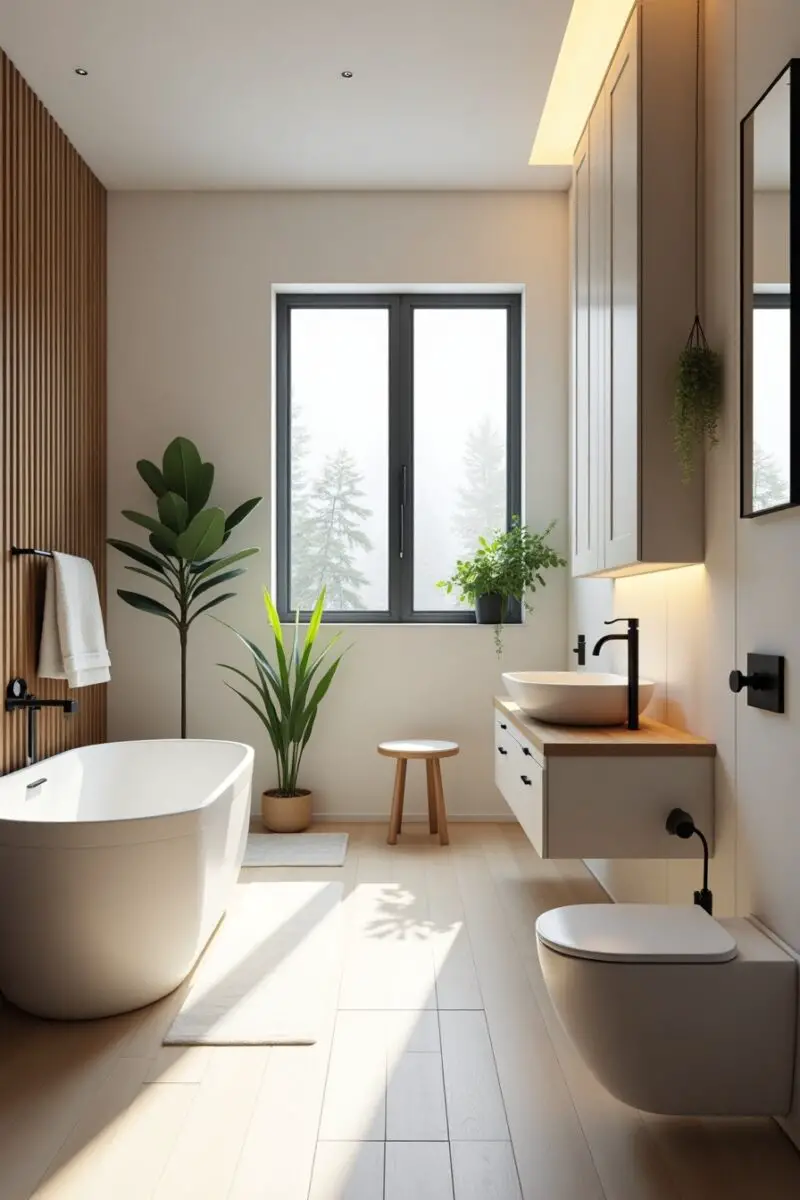
Matte black fixtures serve as striking focal points against the light backgrounds typical of Scandinavian bathrooms, adding depth without overwhelming the space.
This finish choice introduces contemporary edge while maintaining the clean, uncluttered aesthetic central to Nordic design principles.
Unlike chrome or polished nickel, matte black doesn’t show water spots or fingerprints as readily, making it both stylish and practical for daily use.
The non-reflective surface adds a subtle textural element, creating visual interest through contrast rather than shine or ornate details.
Consider extending this finish choice throughout your bathroom for cohesion—faucets, shower fixtures, towel bars, and even hardware on cabinetry can create a unified look.
The boldness of black creates natural focal points, drawing the eye to the functional elements of your bathroom in a deliberate, designed way.
For those hesitant to fully commit, start with smaller elements like towel hooks or cabinet pulls that can be easily changed if tastes evolve.
Mix matte black with natural brass for a warmer interpretation that maintains the contemporary feel while introducing an additional tone.
When selecting black fixtures, look for quality construction with ceramic disc valves and solid brass bodies beneath the finish for longevity and reliable performance.
The minimal profiles typical of Scandinavian-inspired fixtures allow the black finish to make a statement without appearing heavy or overwhelming in the space.
Wall-mounted black faucets pair beautifully with vessel sinks, creating striking geometric compositions that epitomize modern Scandinavian bathroom design.
Black shower frames or hardware create architectural definition within glass enclosures, adding visual structure to these transparent elements.
Consider black plumbing pipe shelving for an industrial touch that provides both storage and display space while maintaining the open, airy feel.
The contrast of black fixtures against white surfaces creates a graphic quality reminiscent of black and white photography—timeless, sophisticated, and visually compelling.
For maximum impact, pair black fixtures with white vessel sinks or bathtubs, allowing the forms to stand in sharp relief against one another.
This high-contrast approach embodies the Scandinavian knack for creating spaces that are simultaneously bold and serene, making a clear design statement without relying on complicated patterns or decorative excess.
✨Click to Get My 101 FREE Designer Room Ideas
Maximize Space with Wall-Mounted Fixtures

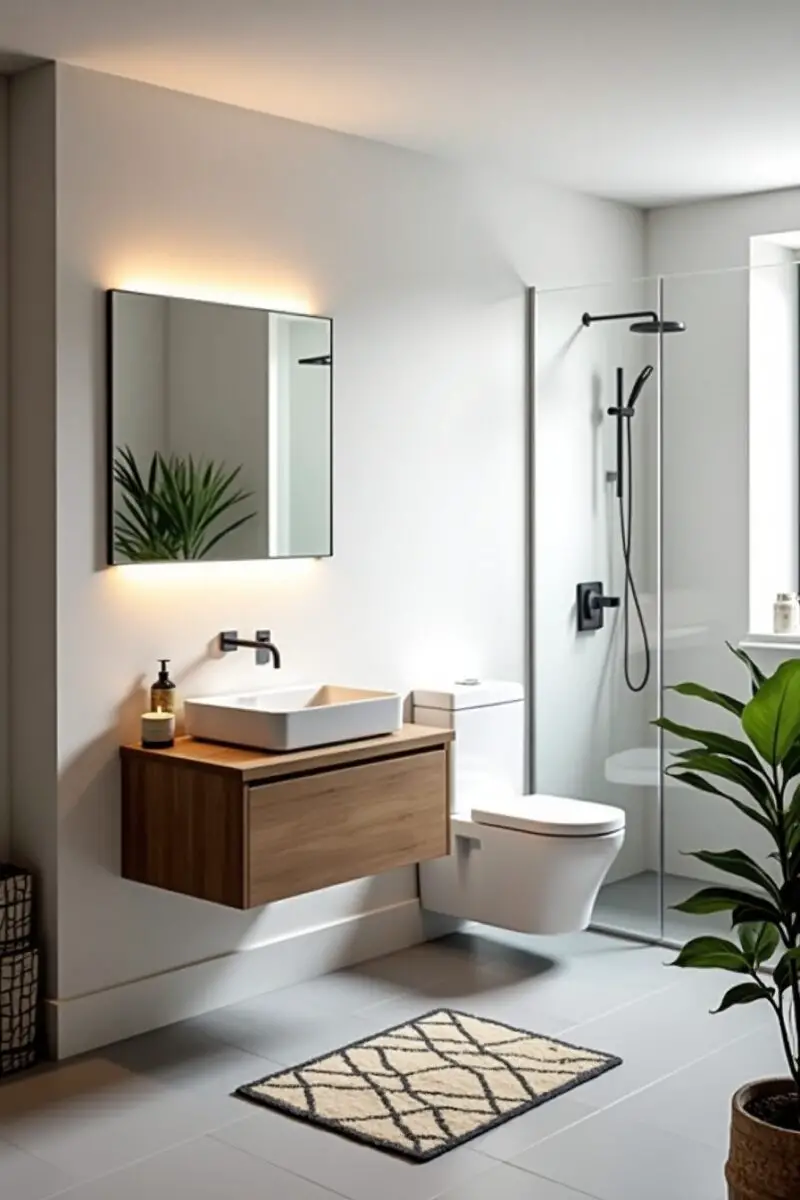
Wall-mounted toilets and vanities create the illusion of more floor space, making even the smallest bathrooms feel more open and spacious.
These floating elements introduce a sense of architectural lightness that aligns perfectly with the Scandinavian preference for uncluttered environments.
The clear floor beneath wall-hung fixtures makes cleaning significantly easier—no more navigating around toilet bases or vanity feet when mopping.
The continuous flow of flooring material beneath these elements creates visual expansion, an especially valuable technique in compact urban bathrooms.
From a design perspective, wall-mounted fixtures appear more intentional and custom, elevating the overall aesthetic of your space beyond standard prefabricated options.
Modern wall-hung toilets conceal their tanks within the wall cavity, creating a streamlined profile that saves up to 9 inches of floor space compared to floor-mounted models.
These systems typically offer dual-flush technology, supporting the Scandinavian commitment to environmental consciousness through water conservation.
Wall-mounted toilets can be installed at your preferred height, adding a custom, ergonomic element that enhances comfort for household members of different heights.
Floating vanities can be positioned at the perfect height for your needs, eliminating the standard height limitations of floor-standing models.
The space beneath a wall-mounted vanity provides convenient storage for items like scales or bath steps that are used regularly but not continuously.
From a lighting perspective, the shadow line created beneath floating fixtures adds architectural interest and depth to the room’s illumination.
Consider extending the wall-mounting concept to medicine cabinets, mirrors, and storage units for a cohesive approach throughout your bathroom.
The installation of these fixtures requires proper structural support within your walls, making them ideal considerations during renovation rather than as afterthoughts.
When selecting wall-mounted vanities, look for solid construction with waterproof materials and ample storage to compensate for the lack of floor cabinetry.
Hidden mounting systems create the magical floating effect, with no visible brackets or supports disrupting the clean lines of your design.
This approach to bathroom fixtures embodies the Scandinavian principle of practical minimalism—elements that serve essential functions while contributing to spatial harmony and visual simplicity.
Amplify Light with Strategic Mirror Placement


Mirrors are essential tools in Scandinavian bathroom design, serving both functional needs and dramatically enhancing the perception of space and light.
In regions where natural light is precious for much of the year, maximizing its presence becomes a design priority addressed through thoughtful mirror positioning.
Consider wall-to-wall mirrors above vanities rather than small, framed versions to reflect maximum light throughout your space.
Position your primary mirror to capture and redistribute natural light from windows or skylights, effectively doubling the perceived brightness in your bathroom.
Round or oval mirrors soften the typically angular lines of bathrooms, adding a gentle counterpoint to rectangular tiles and fixtures.
For a distinctive look, consider a mirror with integrated LED lighting around its perimeter, providing even, shadow-free illumination for grooming tasks.
Backlit mirrors create a floating effect while providing ambient lighting that transforms the mood of your bathroom from clinical to spa-like with the flip of a switch.
Multiple mirrors strategically placed to reflect each other create the illusion of infinite space, particularly effective in smaller bathrooms.
Consider mirrored cabinet fronts for storage units to maintain the light-enhancing properties while hiding everyday clutter.
Full-length mirrors in bathrooms serve both practical dressing needs and visually double the perceived size of your space.
For an authentic Scandinavian approach, choose mirrors with simple frames in natural wood tones or minimal metal finishes that don’t compete with their reflective function.
Tilt-adjustable mirrors accommodate users of different heights while adding a thoughtful, customizable element to your bathroom design.
Position mirrors to reflect your bathroom’s most attractive features, whether that’s a statement bathtub, botanical arrangement, or architectural detail.
Anti-fog technology ensures your mirrors remain functional even after steamy showers, eliminating the practical inconvenience of waiting for surfaces to clear.
Consider the view reflected in your mirror during the planning stages—ideally, it should capture pleasant vistas rather than less attractive functional elements like the toilet.
This strategic approach to mirror placement exemplifies the Scandinavian attention to both aesthetics and functionality, creating spaces that look beautiful while serving practical daily needs.
Add Warmth Through Natural Textiles and Accessories


Textiles provide essential warmth and softness in Scandinavian bathrooms, balancing the cool surfaces of tile, stone, and glass with tactile comfort.
Turkish or waffle-weave cotton towels in neutral tones add subtle texture while maintaining the clean, uncluttered aesthetic central to Nordic design.
Consider linen shower curtains in natural, undyed hues that add organic texture while allowing light to filter through when closed.
Wooden bath mats offer a spa-like alternative to fabric, providing a warm surface underfoot that withstands moisture better than traditional bath rugs.
For cold seasons, introduce sheepskin or high-quality synthetic alternatives as bath mats for extraordinary softness and warmth against bare feet.
Handcrafted ceramic accessories—soap dishes, toothbrush holders, dispensers—add artisanal character while keeping necessary items beautifully organized.
Small wooden stools or benches serve both as practical perches and as surfaces for towels or bath accessories, introducing natural material and craftsmanship.
Consider wall-hanging textiles like small tapestries or macrame pieces that add texture without taking up valuable surface space in compact bathrooms.
Natural sea sponges and wooden bath brushes displayed in simple vessels create functional decoration that aligns with the Scandinavian preference for beautiful utility.
Incorporate woven baskets for toilet paper storage or laundry collection, adding visual warmth through natural materials and handcrafted texture.
Glass containers for cotton balls, swabs, and other necessities transform everyday items into simple, orderly displays rather than visual clutter.
Remember that in Scandinavian design, even the most utilitarian items deserve thoughtful selection—choose tissue box covers and soap pumps with simple, clean designs.
Small wooden trays corral countertop essentials, transforming individual items into a composed arrangement that feels intentional rather than scattered.
Consider a wooden ladder leaned against the wall for hanging towels—a functional sculpture that adds vertical interest while keeping linens accessible.
Scented candles in simple vessels introduce the hygge element of Scandinavian living, creating an atmosphere of comfort and wellbeing through gentle light and subtle fragrance.
These soft elements humanize the bathroom environment, transforming practical spaces into sensory retreats that honor the Scandinavian tradition of finding beauty and comfort in everyday moments.
Layer Lighting for Ambiance and Functionality
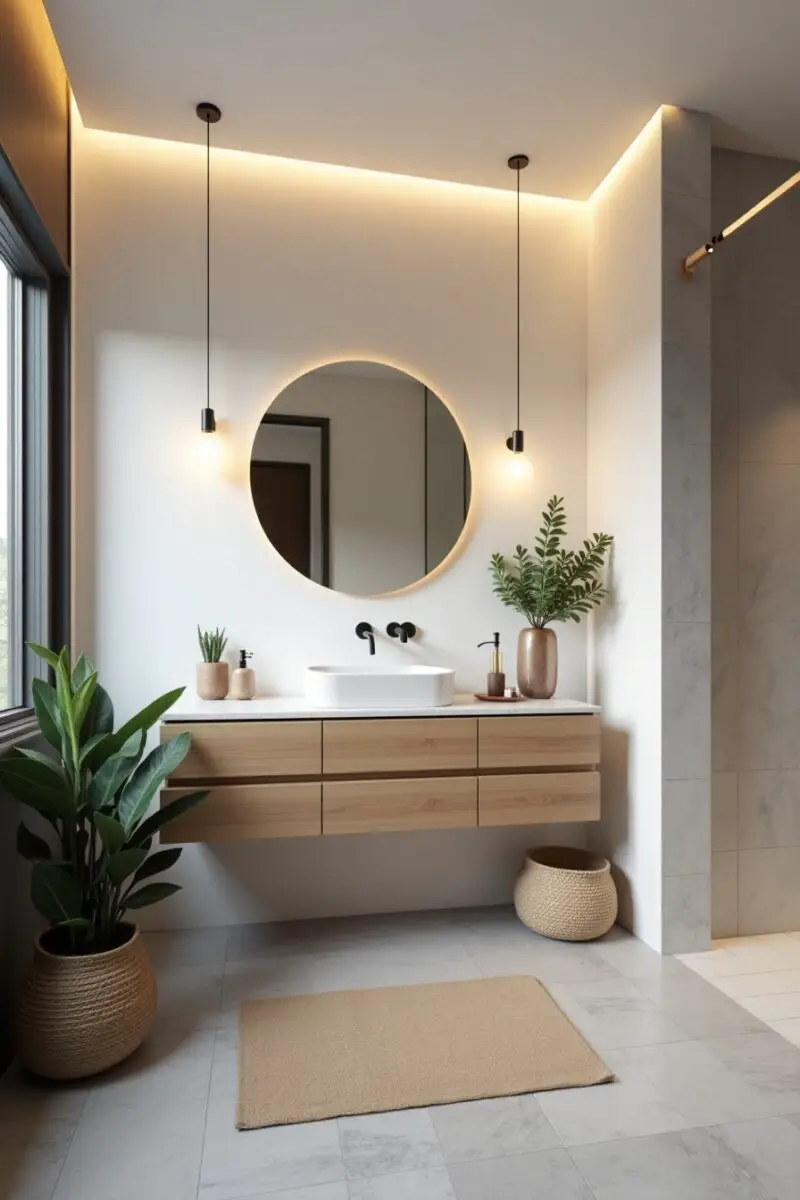

Scandinavian bathroom lighting design recognizes that different activities require different types of illumination, creating layers that can be adjusted throughout the day.
Task lighting around mirrors provides shadow-free illumination for grooming, ideally from both sides and above to eliminate unflattering shadows.
Recessed ceiling fixtures deliver general illumination without visual clutter, maintaining the clean ceiling lines preferred in Scandinavian design.
Consider LED strip lighting installed beneath floating vanities or along toe kicks to create a gentle glow that serves as both practical night lighting and atmospheric enhancement.
Pendant lights with simple glass globes or natural material shades can add a decorative element while providing focused illumination over key areas.
Dimmers on all lighting elements allow customization of the bathroom environment from bright morning routines to gentle evening relaxation.
Waterproof lighting within shower niches highlights beautiful tile work while providing practical illumination for bathing products.
Window treatments that maximize natural light while maintaining privacy are essential—consider frosted glass, light-filtering blinds, or strategically placed clerestory windows.
Motion-activated lighting in lower intensity can provide practical nighttime bathroom access without the jarring effect of full brightness.
Consider the color temperature of your lighting carefully—warmer tones (2700-3000K) create a more inviting atmosphere than the clinical feel of cooler, bluer lights.
Backlit mirrors provide even facial illumination while adding a modern architectural element to your bathroom design.
Skylights or solar tubes bring natural light into interior bathrooms, connecting your space to the changing qualities of daylight throughout the seasons.
Wall sconces with simple, clean lines add mid-level lighting that complements overhead and task sources while creating visual interest on vertical surfaces.
Consider the shadows created by your lighting choices—thoughtfully placed fixtures can highlight architectural features and create atmospheric depth.
Smart lighting systems allow customized scenes for different times of day, automating transitions from energizing morning light to relaxing evening atmospheres.
This layered approach reflects the Scandinavian understanding that light is not merely functional but essential to emotional wellbeing, particularly in regions where natural light varies dramatically throughout the year.
✨Click to Get My 101 FREE Designer Room Ideas
Mix Materials with Intention and Restraint

The most sophisticated Scandinavian bathrooms skillfully combine multiple materials, creating visual interest through thoughtful contrast rather than decorative patterns.
The key to successful material mixing lies in restraint—limiting your palette to three or four complementary materials maintains cohesion while providing adequate variation.
Consider the interaction between hard and soft surfaces—cool marble gains warmth when paired with natural wood, creating a balanced sensory experience.
Concrete elements, whether in vanity countertops, vessel sinks, or shower benches, introduce an industrial edge that contrasts beautifully with more organic materials.
Matte black metal accents can serve as the punctuation marks in your material composition, defining edges and transitions with crisp precision.
Handmade tiles with subtle variation add depth and character without overwhelming the calm aesthetic central to Scandinavian design.
When combining wood species, consider their undertones—keeping them all warm or all cool creates harmony even with varying grains and colors.
Glass partitions and shower enclosures introduce transparency that allows other materials to remain visible throughout the space, creating visual continuity.
Consider the acoustic properties of your material choices—harder surfaces increase echo, while wood and textiles absorb sound for a more comfortable auditory experience.
The transitions between materials deserve special attention—thoughtful details like metal trim between tile and wood demonstrate intentional design consideration.
Natural stone with visible fossil patterns or distinctive veining can serve as nature’s artwork in an otherwise restrained space.
Remember that Scandinavian design embraces materials that age beautifully—patina is considered an enhancement rather than a flaw to be prevented.
Brushed brass or copper elements introduce warmth through metal, particularly effective when used sparingly as accent pieces against cooler backgrounds.
Consider micro-cement for walls or floors—this versatile material creates seamless surfaces with subtle texture that bridges the gap between concrete and plaster.
The most successful Scandinavian bathrooms balance material contrast with color restraint, typically maintaining a predominantly neutral palette that allows textures and natural variation to become the focus.
This intentional mixing of materials creates bathrooms that engage the senses while maintaining the serene simplicity that makes Scandinavian design both timeless and deeply inviting.

